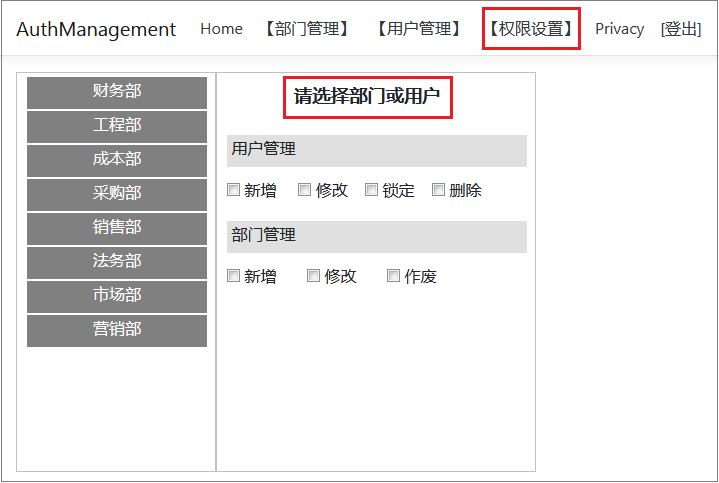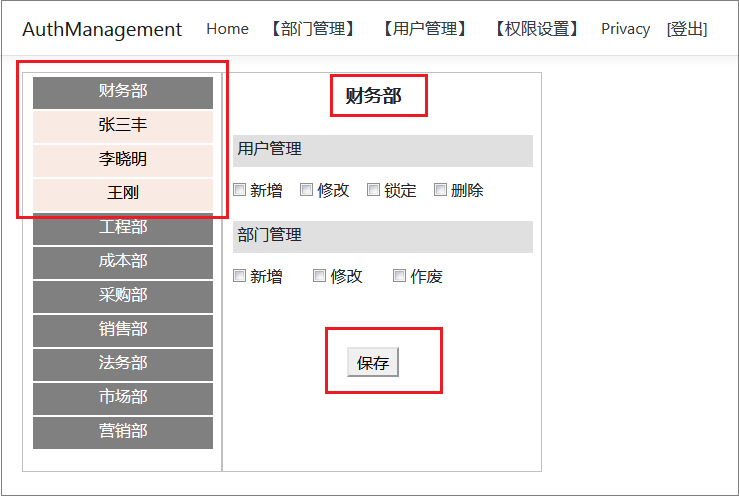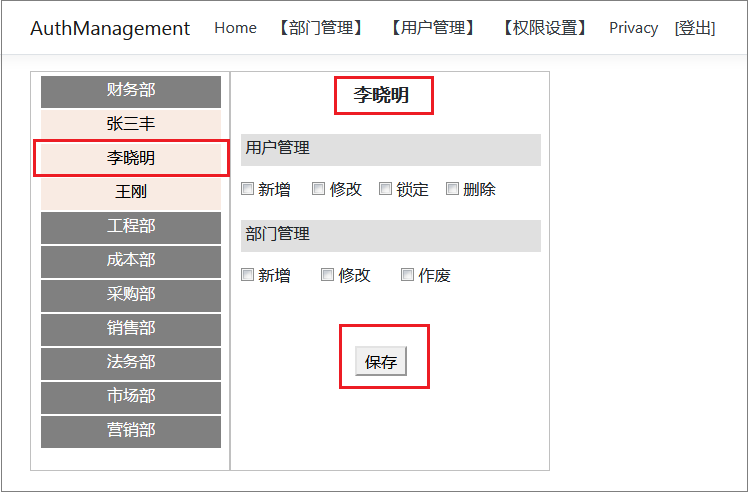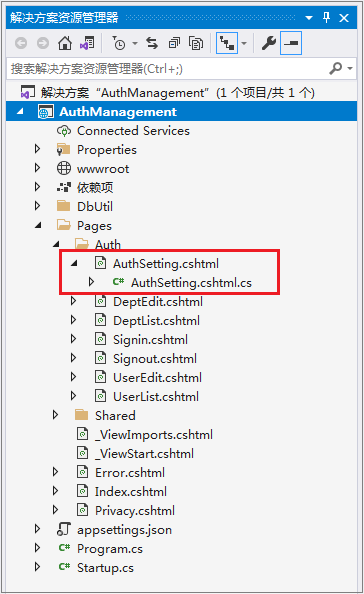权限设置可以针对部门和用户这两个层级,如果设置了部门的权限,
该部门下的所有用户将自动获得部门的权限,如果部门和用户都设置了权限则只取用户部分,忽略部门的权限。
操作流程是这样的:进入权限设置页---> 页面左边显示所有部门--->点部门超链接的时候显示该部门下的员工;
页面右边显示权限点,可以针对部门和员工设置权限,点保存按钮的时候存储到数据库,具体如下:
场景一、用户点【权限设置】时看到的效果如下:

此时提示用户去选择部门或用户,而且保存按钮是不可见的。
场景二、点左边的部门的时候,显示部门下的用户,同时右边显示部门名称和保存按钮,如下:

场景三、点左边部门下的用户的时候,右边显示用户名称,同时显示保存按钮,如下:

代码如下:
在 _Layout.cshtml中增加 【权限设置】菜单,如下:
<ul class="navbar-nav flex-grow-1"> <li class="nav-item"> <a class="nav-link text-dark" asp-area="" asp-page="/Index">Home</a> </li> <li class="nav-item"> <a class="nav-link text-dark" asp-area="" asp-page="/Auth/DeptList">【部门管理】</a> </li> <li class="nav-item"> <a class="nav-link text-dark" asp-area="" asp-page="/Auth/UserList">【用户管理】</a> </li> <li class="nav-item"> <a class="nav-link text-dark" asp-area="" asp-page="/Auth/AuthSetting">【权限设置】</a> </li> <li class="nav-item"> <a class="nav-link text-dark" asp-area="" asp-page="/Privacy">Privacy</a> </li> <li class="nav-item"> @if (Context.User.Identity.IsAuthenticated) { <a class="nav-link text-dark" asp-area="" asp-page="/Auth/Signout">[登出]</a> } else { <a class="nav-link text-dark" asp-area="" asp-page="/Auth/Signin">[登录]</a> } </li> </ul>
在/Auth文件夹下新增 AuthSetting.cshtml 文件,如下:

AuthSetting.cshtml 编码如下:
@page @model AuthManagement.Pages.Auth.AuthSettingModel @using AuthManagement.DbUtil.Entity; @{ ViewData["Title"] = "权限设置"; } <style> .a1{color:#ffffff;} .a2{color:#000000;} .left {float:left;width:200px;min-height:400px;border:solid 1px #c0c0c0;padding-top:2px;padding-bottom:4px;} .right {float:left;width:320px;min-height:400px;border:solid 1px #c0c0c0;padding-top:2px;padding-bottom:4px;} .dept {width:180px;height:32px;background-color:#808080;margin-top:2px; text-align:center;margin-left:10px;} .user {width:180px;height:32px;background-color:#F9EBE3;margin-top:2px; text-align:center;margin-left:10px;} .title {width:300px;height:32px; margin-left:10px;margin-top:20px; background-color:#e0e0e0; } .func {margin-left:10px;margin-top:10px; } .target{width:300px;height:40px; text-align:center; line-height:40px; font-size:18px; font-weight:bold;} .send {width:300px;margin-top:60px; text-align:center;} </style> <div> <!--左边区块显示部门及部门下的用户--> <div class="left"> @foreach (TDept dept in Model.DeptList) { <div class="dept"><a class="a1" href="/Auth/AuthSetting?deptid=@dept.DeptId">@dept.DeptName</a></div> <!--遍历的部门==用户点击的部门就显示其下的用户--> if (Request.Query["deptid"] == dept.DeptId.ToString()) { foreach (TUser user in Model.UserList) { <div class="user"><a class="a2" href="/Auth/AuthSetting?deptid=@user.DeptId&userid=@user.UserId">@user.UserName</a></div> } } } </div> <!--右边区块显示权限点--> <div class="right"> <form method="post"> <div class="target">@Model.TargetInfo.TargetName</div> <div class="title"> 用户管理</div> <div class="func"> @if (Model.AuthArray.Contains<string>("TUser-Add")) { <input type="checkbox" name="funccode" value="TUser-Add" checked="checked" /><span> 新增 </span> } else { <input type="checkbox" name="funccode" value="TUser-Add" /><span> 新增 </span> } @if (Model.AuthArray.Contains<string>("TUser-Modify")) { <input type="checkbox" name="funccode" value="TUser-Modify" checked="checked" /><span> 修改 </span> } else { <input type="checkbox" name="funccode" value="TUser-Modify" /><span> 修改 </span> } @if (Model.AuthArray.Contains<string>("TUser-Lock")) { <input type="checkbox" name="funccode" value="TUser-Lock" checked="checked" /><span> 锁定 </span> } else { <input type="checkbox" name="funccode" value="TUser-Lock" /><span> 锁定 </span> } @if (Model.AuthArray.Contains<string>("TUser-Delete")) { <input type="checkbox" name="funccode" value="TUser-Delete" checked="checked" /><span> 删除 </span> } else { <input type="checkbox" name="funccode" value="TUser-Delete" /><span> 删除 </span> } </div> <div class="title"> 部门管理</div> <div class="func"> @if (Model.AuthArray.Contains<string>("TDept-Add")) { <input type="checkbox" name="funccode" value="TDept-Add" checked="checked" /><span> 新增 </span> } else { <input type="checkbox" name="funccode" value="TDept-Add" /><span> 新增 </span> } @if (Model.AuthArray.Contains<string>("TDept-Modify")) { <input type="checkbox" name="funccode" value="TDept-Modify" checked="checked" /><span> 修改 </span> } else { <input type="checkbox" name="funccode" value="TDept-Modify" /><span> 修改 </span> } @if (Model.AuthArray.Contains<string>("TDept-Cancel")) { <input type="checkbox" name="funccode" value="TDept-Cancel" checked="checked" /><span> 作废 </span> } else { <input type="checkbox" name="funccode" value="TDept-Cancel" /><span> 作废 </span> } </div> @if (Model.TargetInfo.TargetId > 0) { <div class="send"><button type="submit">保存</button></div> } </form> </div> <div style="clear:both;"></div> </div>
AuthSetting.cshtml.cs 编码如下:
using System; using System.Collections.Generic; using System.Linq; using AuthManagement.DbUtil.Entity; using Microsoft.AspNetCore.Mvc.RazorPages; namespace AuthManagement.Pages.Auth { public class AuthSettingModel : PageModel { private readonly AuthDbContext _context; //构造函数中对 AuthDbContext 做依赖注入 public AuthSettingModel(AuthDbContext context) { _context = context; } public List<TDept> DeptList { get; private set; } public List<TUser> UserList { get; private set; } public TargetInfo TargetInfo { get; private set; } public string[] AuthArray { get; private set; } private void InitDeptList() //初始化页面的部门列表 { DeptList = _context.TDepts.Where<TDept>(dept => dept.IsValid == 1).ToList<TDept>(); } private void InitUesrList() //初始化用户列表,如果没有点部门的时候为空 { string deptId = Request.Query["deptid"]; int did = Convert.ToInt32(deptId); UserList = _context.TUsers.Where<TUser>(x => x.DeptId == did).ToList<TUser>(); } private void InitTargetInfo() //初始化权限设置对象信息 { TargetInfo = new TargetInfo { TargetId = 0, TargetName = "请选择部门或用户" }; string deptId = Request.Query["deptid"]; string userId = Request.Query["userid"]; if (!string.IsNullOrWhiteSpace(userId)) { TUser user = _context.TUsers.Find(Convert.ToInt32(userId)); TargetInfo.TargetId = Convert.ToInt32(userId); TargetInfo.TargetName = user.UserName; } else if (!string.IsNullOrWhiteSpace(deptId)) { TDept dept = _context.TDepts.Find(Convert.ToInt32(deptId)); TargetInfo.TargetId = Convert.ToInt32(deptId); TargetInfo.TargetName = dept.DeptName; } } private void InitAuthArray() //初始化权限数组,把该部门或用户的权限code都取出来(授权类型 1:部门,2:用户) { IQueryable<TAuth> authList = null; string deptId = Request.Query["deptid"]; string userId = Request.Query["userid"]; if (!string.IsNullOrWhiteSpace(userId)) { authList = _context.TAuths.Where<TAuth>(x => x.TargetType == 2 && x.TargetId == Convert.ToInt32(userId)); } else if (!string.IsNullOrWhiteSpace(deptId)) { authList = _context.TAuths.Where<TAuth>(x => x.TargetType == 1 && x.TargetId == Convert.ToInt32(deptId)); } if (authList == null || authList.Count() < 1) { AuthArray = new string[1] { "" }; } else { //用LINQ把查询出来的权限集合中的funcCode找出来并转化成字符数据, //前端页面可以判断单个权限是否存在,决定checkbox是否要勾选。 AuthArray = (from TAuth auth in authList select auth.FuncCode).ToArray<string>(); } } public void OnGet() //第一次加载页面 { InitDeptList(); InitUesrList(); InitTargetInfo(); InitAuthArray(); } public void OnPost() //点保存按钮的时候 { string deptId = Request.Query["deptid"]; string userId = Request.Query["userid"]; string allFuncCode = Request.Form["funccode"]; if (string.IsNullOrWhiteSpace(allFuncCode)) return; string[] arrCode = allFuncCode.Split(","); if (!string.IsNullOrWhiteSpace(userId)) //优先处理用户的权限 { int uid = Convert.ToInt32(userId); SaveUserAuth(arrCode, uid); //保存用户权限 } else if (!string.IsNullOrWhiteSpace(deptId)) { int did = Convert.ToInt32(deptId); SaveDeptAuth(arrCode, did); //保存部门权限 } //初始化页面数据 OnGet(); Response.Redirect("/Auth/AuthSetting?deptid="+ deptId + "&userid="+ userId); } private void SaveUserAuth(string[] arrFuncCode, int userId) //保存用户权限 { //先将该用户已有的权限全部删除,然后再批量插入(授权类型 1:部门,2:用户) List<TAuth> newList = new List<TAuth>(); foreach (string str in arrFuncCode) { TAuth tauth = new TAuth { CreateTime = DateTime.Now, FuncCode = str, TargetId = userId, TargetType = 2 }; newList.Add(tauth); } IQueryable<TAuth> existList = _context.TAuths.Where<TAuth>(x => x.TargetType == 2 && x.TargetId == userId); _context.TAuths.RemoveRange(existList);//批量删除 _context.TAuths.AddRange(newList);//批量增加 _context.SaveChanges();//执行数据库操作 } private void SaveDeptAuth(string[] arrFuncCode, int deptId) //保存部门权限 { //先将该部门已有的权限全部删除,然后再批量插入(授权类型 1:部门,2:用户) List<TAuth> newList = new List<TAuth>(); foreach (string str in arrFuncCode) { TAuth tauth = new TAuth { CreateTime = DateTime.Now, FuncCode = str, TargetId = deptId, TargetType = 1 }; newList.Add(tauth); } IQueryable<TAuth> existList = _context.TAuths.Where<TAuth>(x => x.TargetType == 1 && x.TargetId == deptId); _context.TAuths.RemoveRange(existList);//批量删除 _context.TAuths.AddRange(newList);//批量增加 _context.SaveChanges();//执行数据库操作 } } //为了页面处理数据方便,定义一个TargetInfo对象来记录用户选择的目标对象信息 public class TargetInfo { public int TargetId { get; set; } //部门或用户编号 public string TargetName { get; set; } //部门或用户名称 } }
编译运行程序,分别对一个部门和一个用户设置权限,可以看到数据库已经把权限值保存下来了:

最后,在实际项目中还需要写一个API 方法,方法签名是 bool CheckAuth(string funcCode, int userId) ,
当用户在点击相关按钮时候判断是否有操作权限 , 这里就不展开了。
.net5 core Razor项目实战系列之十:权限设置功能的实现(EFCore的批量删除与批量新增)
原文:https://www.cnblogs.com/pfm33/p/14771213.html